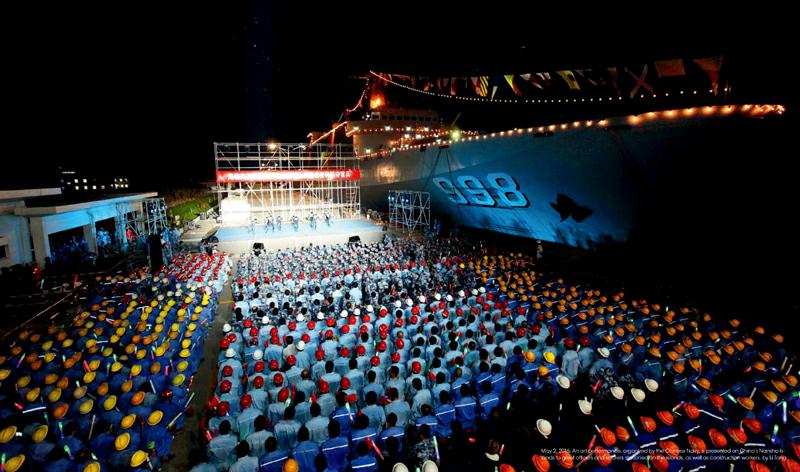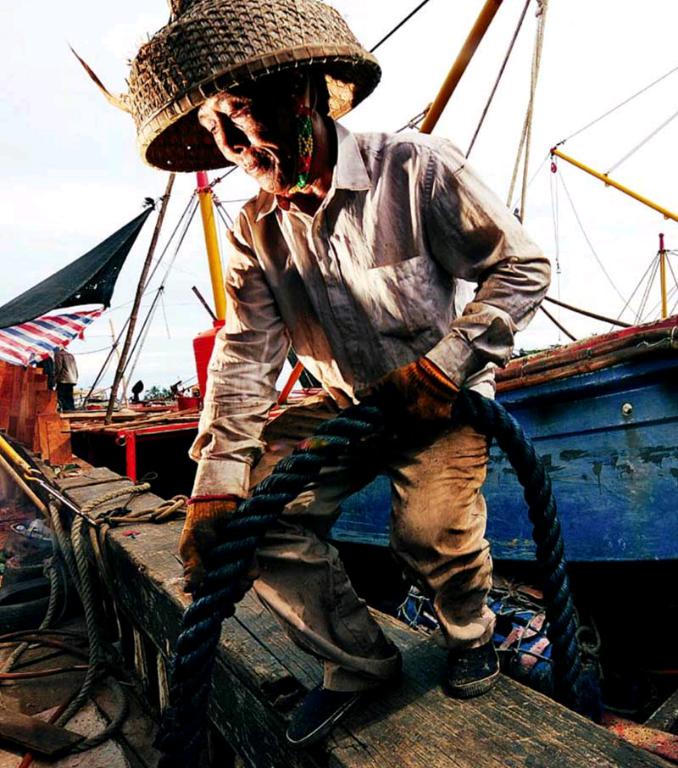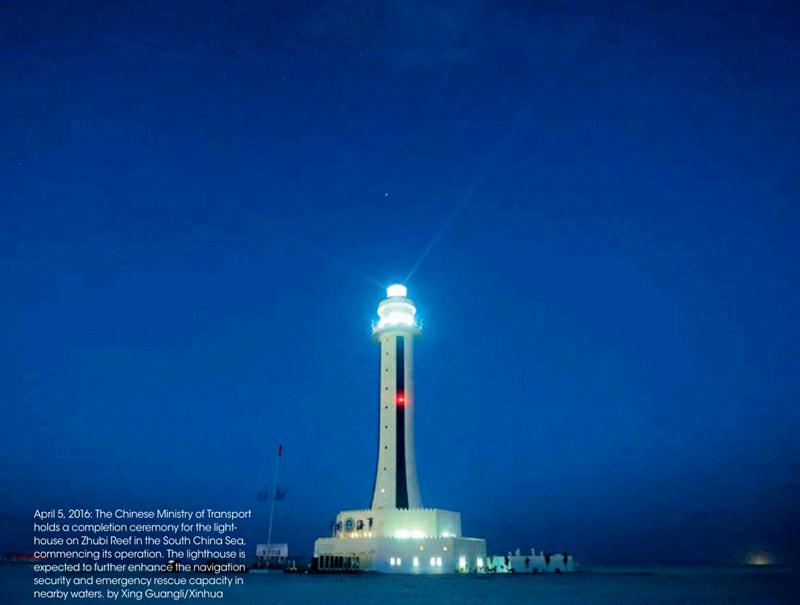South China Sea:How We Got to This Stage
2016-06-21byFuYingandWuSh
by+Fu+Ying+and+Wu+Shicun
Recently, The National Interest published an article co-authored by Ms. Fu Ying, chairperson of the Foreign Affairs Committee of Chinas National Peoples Congress and chair of the Academic Committee of Chinas Institute of International Strategy at the Chinese Academy of Social Sciences, and Mr. Wu Shicun, Ph.D., senior research fellow and president of the National Institute of South China Sea Studies. This article provides an overview of the chain of events contributing to the escalation of tensions in the South China Sea, as well as the context in which they occurred and potential connections they have. The following are excerpts from the article.
The South China Sea issue has become one of the major irritants in the China-U.S. relations in recent years, over which the public opinion in the two countries has been very critical of each other.
The latest rhetoric is about “militarizing the South China Sea”, and on the part of the U.S., announcements to carry out “freedom of navigation operational assertions”. Hawkish voices are growing louder in both sides of the Pacific. Such frictions surrounding the South China Sea are leading to further strategic mistrust and hostility. The American scholar David M. Lampton was straightforward when he observed worriedly in reference to the existing situation, “A tipping point in the U.S.-China relations is upon us.”It is obvious that the South China Sea issue is a major catalyst for the troubled China-U.S. relations, if not the key contributing factor.
Imperial Japans Occupation of the Nansha Islands and Post-war Arrangements
The South China Sea is the largest marginal sea in the West Pacific region, covering an area of 3.5 million square kilometers. China has sovereignty over four archipelagos in the South China Sea, namely, the Xisha, Nansha, Zhongsha and Dongsha Islands, which are indicated by the dash lines on the map drawn in 1947. Before the 1930s, there was no dispute over Chinas ownership of them, as reflected in many maps and encyclopedias published around the world.
In 1939, Japan occupied part of the Nansha Islands in an effort to control Southeast Asia and in preparations for an invasion of Australia.
The Cairo Declaration of November 1943, signed by the heads of the governments of China, the United States and the United Kingdom, proclaimed that “…Japan shall be stripped of all the islands in the Pacific which she has seized or occupied since the beginning of the first World War in 1914, and that all the territories Japan has stolen from the Chinese, such as Manchuria, Formosa, and the Pescadores, shall be restored to the Republic of China.”

In the face of the division of both sides of the Taiwan Straits, the outbreak of the Cold War and tensions between the two Camps, the U.S. opted for a pragmatic attitude toward the ownership of the islands and reefs in the South China Sea. This pragmatism was reflected in the Peace Treaty of San Francisco between Japan and some of the Allied Powers. Signed on September 8, 1951 and effective as of April 28, 1952, the document served to end the Allied post-war occupation of Japan and establish Japans role in the international arena. It officially renounced Japans rights to the land it occupied including renunciation of“all right, title and claim to the Spratly Islands and to the Paracel Islands”. Its Article 2(6) stipulated that “Japan renounces all right, title and claim to the Spratly Islands (the Nansha Islands) and to the Paracel Islands (the Xisha Islands),” but did not specify the ownership of these islands.
However, despite its history as the biggest victim of the Japanese militarism and one of the four major victors in WWII, the PRC was not invited to the treaty talks held in San Francisco. In reaction to that, on 15th August, the Chinese government issued the Declaration on the Draft Peace Treaty with Japan by the U.S. and the U.K. and on the San Francisco Conference by the then Foreign Minister Zhou Enlai, affirming Chinas sovereignty over the archipelagos in the South China Sea, including the Nansha Islands, and protesting about the absence of any provisions in the draft on who shall take over the South China Sea islands following Japans renouncement of all rights, title and claim to them. It reiterated that“the Chinese government of the day had taken over those islands”and that the PRCs rightful sovereignty “shall remain intact”.
Disputes during the Cold War
Since mid-1950s, the Philippines and South Vietnam started their encroachment of the Nansha Islands.
A bigger wave of encroachment happened in the 1970s and 1980s, under the influence of the discovery of rich oil and gas reserves on the continental shelve of the South China Sea by the U.S. and a number of UN survey agencies in the late 1960s, and the signing of the United Nations Convention on the Law of the Sea in 1982, which introduced the 200 nautical mile exclusive economic zone (EEZ) regime.
Greatly incentivized by a high potential for resource exploration, Vietnam, the Philippines and Malaysia set their sights on islands and reefs in the Nansha Islands. At the same time, these countries dramatically altered their original stance on the issue of the Nansha Islands. By formulating national laws of the sea and issuing political statements, they officially asserted sovereignty over the Nansha Islands and made claims on the territorial waters surrounding the Nansha Islands.


At the same time, the U.S. clearly demonstrated its acknowledgment of Chinas sovereignty over the Nansha Islands in its diplomatic inquiries, measurement requests and flight plan notifications. In addition, the Taiwan authorities have also received the American military personnel on Nansha Island where it stationed forces. For a long period of time, the U.S. remained silent to the encroachments by the Philippines and Vietnam, but it did consult the Taiwan authorities on many occasions related to the sovereignty issue over these islands and reefs. From February 1957 to February 1961 the U.S. government made multiple application requests to the Taiwan authorities to allow the U.S. Air Force based in the Philippines to conduct nautical chart measurement and meteorological surveys in the vicinity of Huangyan Island (Scarborough Reef) and the Nansha Islands, obviously acknowledging Chinas sovereignty over these islands through the consultation of the Taiwan authorities. Such acknowledgment was confirmed in books and maps published around this time such as Columbia Lippincott Gazetteer of the World (1961), Worldmark Encyclopedia of the Nations (1963), and Constitutions of the Countries of the World (1971), all of which clearly state that the Nansha Islands belong to China. Indeed, the U.S. policy-makers faced a dilemma at that time: on one hand, out of a moral commitment to its Chinese Nationalist ally in Taiwan, and in accordance with international law, the U.S. should have announced these features as Chinese territory; on the other hand, out of its anti-communism policy and Asia-Pacific strategy, it could not possibly recognize the Chinese mainland as their rightful owner, nor did it want to hurt its relations with its important allies, such as the Philippines, through such recognition.
As far as China is concerned, over the years, only the Taiwan authorities had station forces on Taiping Island. Its not until the late 1980s in the 20th century when the Chinese mainland started to take control over six minor islands and reefs. In 1994, China built fishery and sheltering facilities on Meiji Reef.
The Road to the Declaration on the Conduct of Parties in the South China Sea

In the early 1990s, as the Cold War came to an end, the relations among the countries began to reconcile and economic development became the primary focus in the APAC region, China switched onto a fast track toward establishing rapport with Southeast Asian countries and the Association of Southeast Asian Nations (ASEAN).
China then embarked on a path of confidence-building and allround cooperation with ASEAN, guided by its new foreign policy of realizing and maintaining stability in Southeast Asia. In spite of all these developments, sovereignty over the Nansha Islands remained the most frequently debated issue between China and its ASEAN neighbors. China, based on its historical ownership of these islands and widely-recognized international documents, consistently defended its indisputable sovereignty over them as it had done in the past. On the other hand, China decided to copy here its policy of “setting aside dispute and pursuing joint development”, which was practiced over the Diaoyu Island of the East China Sea, for the sake of cooperation and regional stability. However, China made clear this did not mean renouncing its sovereignty over the Nansha Islands.
Throughout the 1990s, the rapid development of the ChinaASEAN relations largely masked seething contention in the South China Sea; nevertheless, disputes surfaced from time to time.
The Chinese government, with a view to stopping the dispute from boiling over and maintaining the sound China-ASEAN partnership, resorted to a concerted diplomatic effort featuring consultations with countries like Vietnam, Malaysia and especially the Philippines. Tensions began to ease. In March 1999, the working group on the development of confidence-building measures held their first meeting in Manila, at which both sides agreed, after multiple consultations, to exercise restraint and refrain from taking any action that could escalate disputes.
An informal consultation was held between China and the ASEAN countries in Thailand on March 15, 2000, and “the code of conduct” documents respectively drafted by both sides were exchanged and discussed. However, due to considerable differing views on its binding powers among the parties, and China and Vietnams differences on the areas it should cover, the drafting process did not go very well, and subsequent consultations yielded no substantial outcome.
With a view to diffuse the standoff, Malaysia proposed to replace “the code of conduct” with a compromising and non-binding“declaration” at the 35th ASEAN Ministerial Meeting held in Bandar Seri Begawan, Brunei, in July 2002. Several months later, a consultation on the Declaration on the Conduct of Parties in the South China Sea (DOC) was held in place of a consolation on“the code of conduct”, where both sides engaged in many rounds of difficult negotiations. At the 8th ASEAN Summit convened in Phnom Penh, Cambodia, on November 4, 2002, Mr. Wang Yi, then Vice Minister of Foreign Affairs, and Foreign Ministers of the ten ASEAN Member States jointly signed the DOC.
Shortly after the Cold War ended, the U.S. remained committed to its previous policy of not taking sides on the legitimacy of territorial claims, emphasizing that the disputes should be peacefully resolved, and that the freedom of navigation in the South China Sea should be maintained. As Asia was not the focal point of the U.S.s global policy at that time, the occasional reemergence of disputes over the Nansha Islands did not move the U.S. to change its neutral stance. It stressed that parties concerned should settle territorial disputes through peaceful means.
A Decade with Tensions Simmering under the Surface
In nearly ten years after the introduction of the DOC, China was the only party to faithfully abide by the document. It refrained from taking actions that might escalate the dispute in the South China Sea, and kept pushing for peace and cooperation and joint development in disputed areas. By contrast, Vietnam, Malaysia, the Philippines and some other ASEAN countries were half-hearted about the DOC. They kept on transforming and expanding occupied islands, reinforcing their administrative management of them, and accelerated the development of oil and gas resources in surrounding waters. They also made occasional arrests of Chinese fishermen working in these waters. One common effort of these countries is to solidify their illegal occupation and extend the territorial dispute to the maritime sphere. What they were trying to do was more of denying the existence of the disputes than shelving them. This continuously enraged the Chinese public and media, eliciting sustained attention.
But it must be admitted that despite a continuing tug-of-war in the South China Sea, the general situation was under control before 2009. Soon thereafter, things became more complicated, mostly due to an official deadline set by the UN Commission on the Limits of the Continental Shelf (CLCS), according to which relevant states should submit claims over a continental shelf extending the 200 nautical miles from its territorial sea by May 15, 2009. An even greater factor is the introduction of the American Asia-Pacific rebalancing strategy.
Chinese diplomatic efforts to maintain stability in the South China Sea and diffuse tensions with ASEAN countries continued. China achieved some progress through its painstaking efforts to seek to resolve disputes via peaceful talks. At the ASEAN-China Ministerial Meeting (10+1) held in Bali, Indonesia in July 2011, the Guidelines to Implement the DOC was adopted by China and ASEAN countries. China reached some understanding with the Philippines and Vietnam through bilateral negotiations. Still, these efforts were not enough to offset U.S.s Asia-Pacific rebalance strategy, and claimants like the Philippines and Vietnam, in turn, didnt display much restraint.
These provocative activities by some ASEAN member countries and the U.S.s intervention have been closely watched and widely reported in China, evoking strong repercussions among the public. Under the doubling-down pressure of policy sustainability and public opinion, Chinas restraint policy is approaching to its brink.
Tensions as Result of Wrestling among Multiple Players
In April 2012, the Philippine Navy made a provocative arrest of Chinese fishermen working in the Huangyan Island waters in what was later known as the Huangyan Island Incident. Arguably this became the “last straw on the camels back” in the fragile stability in the South China Sea, and it tested the bottom line of Chinas policy and patience.
As if the Huangyan Island Incident was not bad enough for tensions, Vietnam adopted its domestic Maritime Law on June 21, in an attempt to legalize its territorial claims in the South China Sea.
On January 22, 2013, the Philippines initiated arbitral proceedings against China at the International Tribunal for the Law of the Sea. As far as arbitration is concerned, China already made a declaration on optional exceptions in 2006 under Article 298 of the UN Convention on the Law of the Sea. Since the Arbitration Court jurisdiction concerns sovereignty, historic rights and entitlement, China is exempt from the arbitration. There is no provision in the convention to enforce an adverse award on China.
In 2013, in view of the changing situation in the South China Sea, and to meet the civil and defense needs on the islands and to defend its sovereignty, China launched reclamation projects on its controlled Nansha islands. As all of these islands are far away from the international navigation routes, there was no question of these projects having any impact on the freedom of navigation. But the U.S. and the Philippines kept accusing China and hyping the issue.
Chinas actions have not been fully understood by its neighbors who expressed concerns. The U.S. also stepped up its intervention, buzzing over Chinas island reclamation projects using rhetoric like “reaching too far and too fast” and “islands militarization” to pile pressure on China, and even sending ships to sail near the Nansha and Xisha Islands. All these moves were perceived in China as serious security challenges.
From the perspective of many Chinese people, the U.S. is the invisible hand behind the rising tension in the South China Sea.
Since 2014, the U.S. has made clearer responses to China in the South China Sea, in postures of direct intervention in the disputes and often in favor of other claimants, especially its own allies.
From the Chinese perspective, as well as undermining the U.S. credibility as a potential mediator, the U.S.s dramatically altered policy on the South China Sea has heightened Chinas fears that its interests would be further undermined, thus inspiring its determination and measures to defend them.
Cooperation Leads to Win-Win Result
It can be seen from the above narrative that the situation in the South China Sea came to the state of where we are today is the result of the entangling effect of the actions and reactions along multiple lines. There is also influence from the changes in the international and regional security environment. The elements that pushed the spiraling twists and turns include not only sovereignty, resources and strategic security considerations, but also tangible interests. There is also the problem of information dis-link and historical and institutional memory loss. Moreover, the guessing game about each others strategic intentions and policy objectives is also playing a role. The U.S. as a power from outside the region has played a major role by coming into the issue and adjusting its policies towards the region since 2009.
Chinas pursuit in the South China Sea has been consistently maintained. That is to safeguard national territorial integrity and maintain regional peace and tranquility. To observe China, one should never lose sight of the historical dimension. Though China is growing into a strong country, the painful memory of history is not long gone. The Chinese people have not forgotten that the country stumbled into the 20th century with its capital under the occupation of the imperialists armies, and for over a century before and after, China suffered the humiliation of foreign invasion and aggression. That is why the Chinese people and government are very sensitive about anything that is related to territorial integrity and would never allow such recurrence even if its just an inch of land. This is something the outside world needs to keep in mind when looking at China and trying to understand Chinas behavior. Admittedly, there is no major external threat that can endanger Chinas survival or development in todays world. China adheres to the path of peaceful development and it dedicates to promoting world peace, development and cooperation. Its belief and commitment are firm and unchanged.
In his speech at the Opening Ceremony of the Fifth Meeting of the CICA Ministers of Foreign Affairs on April 28, 2016, the Chinese President Xi Jinping stated: “Let me stress that China is committed to maintaining peace and stability in the South China Sea. We firmly stand by our sovereignty and rights and interests in the South China Sea, and remain committed to resolving disputes peacefully through friendly consultation and negotiation with countries directly concerned.” From the consultations the Chinese Foreign Minister Wang Yi held in recent months with his counterpart among ASEAN countries, one could also see that Chinas proposition of “dual-track” approach, meaning disputes be resolved peacefully through negotiation between the parties directly concerned and China and ASEAN countries work together to maintain peace and stability in the South China Sea, has been well received and supported. ASEAN start to realize the importance of keeping the situation under control and return to the track of dialogue.
The future direction of trend would very much depend on the perceptions and choices of the parties involved. If they choose to cooperate, they may all win. If they choose to confront each other, they may only head for impasse or even conflict and no one can
benefit totally.
